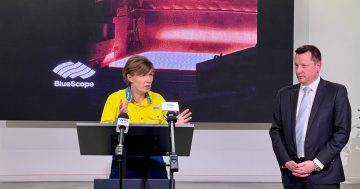
Hysata CEO Paul Barrett at the Hysata lab. Photo: Hysata.
In 2019 Paul Barrett was a partner at major venture capital firm IP Group Australia when he was introduced to a transformational clean energy technology at the lab benches of the University of Wollongong (UOW).
When he looked into it, what he discovered blew him away.
Professor Gerry Swiegers from UOW’s Intelligent Polymer Research Institute (IPRI) and his team of experienced researchers had broken down a major barrier in the fight against global warming, and it centred around electrification.

Hysata CTO Dr Gerry Swiegers, CEO Dr Paul Barrett and VP Engineering Scott Abrahamson. Photo: Hysata.
Electrification is pivotal for Australia to achieve its net-zero goals. However, the “hard to abate” sectors such as steel, chemicals, high-grade heat and heavy transport were being left behind in the pursuit – until now.
The answer is green hydrogen, which is expected to contribute 20 per cent of the total emissions abatement required by 2050 to reach net zero globally through decarbonising these sectors. However, the key technology for producing green hydrogen – the electrolyser – is complex, costly, only moderately efficient and difficult to scale. Over 50 years, there have only been incremental improvements in these systems.
Paul, with his PhD in chemical engineering, immediately recognised the potential in the electrolyser technology developed by Gerry and his team to accelerate the market viability of green hydrogen replacing fossil fuels as an energy source.
“Gerry has worked in the hydrogen industry for over 30 years and is a globally renowned electrochemistry expert. He has always approached his work with a practical edge, seeking out problems to solve in the industry,” he says.
“Electrolysers today are expensive and inefficient. He and the team drilled into the root cause of the efficiency losses and, using clever engineering, attacked them.”
The resulting technology, called “capillary-fed electrolysis” formed the nucleus of a spin-off company – Hysata.
Paul has since brought into the company experts in global partnership building, mass manufacturing veterans, and world-class talent in engineering, research and development, and commercial talent to ensure the company can not only achieve transformational performance, but so that it can do so at scale.
Hysata now has 60 employees and aims to grow to hundreds in coming years.
In 2021 Paul led the seed round of funding and post the close of ‘Series A’ funding of $42.5 million last year, joined as CEO.
Hysata’s electrolyser splits water into hydrogen and oxygen, producing green hydrogen with no emissions profile. Unlike natural gas, green hydrogen only produces water vapour.
Hysata’s electrolyser systems boast 95 per cent efficiency, reducing the ‘levelised cost of hydrogen’ (LCOH) by one fifth when compared with incumbent technologies, and saving project developers billions of dollars in renewable generation capital expenditure.

The Hysata electrolyser has a 20 per cent efficiency advantage over incumbent technology. Photo: Hysata.
Considered crucial in the decarbonisation of hard to abate sectors, green hydrogen is expected to supply up to 15 per cent of energy in a net-zero global economy, presenting an enormous commercial and decarbonisation opportunity for electrolysers.
The feat has been lauded on national platforms including Nature Communications, Financial Review and Bloomberg. Hysata has won millions more in funding and cleaned up on the awards front, most recently at the Illawarra Business Awards where the team claimed top gong, among others.
There’s work ahead, however.

Paul says the team is justifiably optimistic about the future. Photo: Hysata.
When built to industrial scale, Hysata’s electrolyser has roughly the same footprint as a shipping container and requires megawatts of power to produce hydrogen.
A typical chemical facility might need hundreds of those shipping containers to power their operations with green hydrogen.
There are one thousand megawatts in a gigawatt, and one thousand gigawatts in a terawatt – and terawatts are what’s needed globally to deeply decarbonise the sectors that Hysata is targeting.
To provide scale, the capacity of Australia’s power grid today is 50 gigawatts.
“Yes, the critical role electrolysers will play in decarbonisation is undeniable, and we will need a lot of them,” Paul says.
But Hysata has not only the technology – the company has also built the way to mass manufacturing. Next year, the company’s 8000-sqm electrolyser manufacturing facility beside Port Kembla’s beautiful MM Beach, will house a state-of-the-art manufacturing line that will allow it to produce commercial sized units, slated for delivery from 2025.

Next year, Hysata’s 8000-sqm electrolyser manufacturing facility beside Port Kembla’s beautiful MM Beach will be able to produce commercial-sized units. Photo: Hysata.
Paul says the team is justifiably optimistic about the future.
“Our technology is world leading,” he says.
“Our 95 per cent efficiency gives a 20 per cent advantage over incumbent technology and is already ahead of the International Renewable Energy Agency’s 2050 electrolyser efficiency target.
“This isn’t only about seizing a tremendous business opportunity. It’s also about rapidly decarbonising the hard to abate sectors. It’s about innovation that will save billions and contribute profoundly to a cleaner planet.”
Inside Industry conducts Clean Energy Tours of Port Kembla including the Hysata facility – learn more here.

















